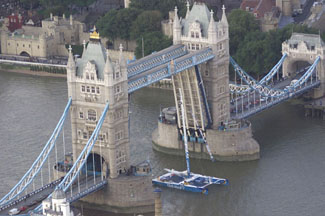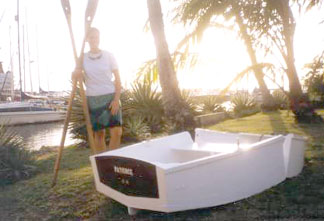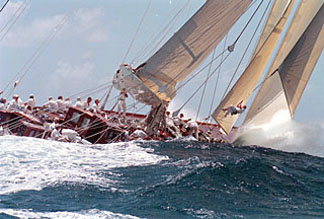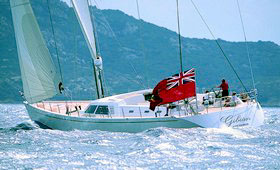
|
|
October 9 - London
| On October 6, Grant Dalton's state-of-the-art
maxi cat 'Club Med' passed under centuries old Tower Bridge on
the way to a London publicity event for the upcoming The Race
around the world race. This had to sting more than a little for
the Brits, as just the day before their own $6 million 'Team
Phillips' entry, led by former Royal Marine Pete Goss, broke
down again after just 24 hours with problems related to the bottom
bearing of one of the two radical unsupported windsurfer style
masts. Goss' initial assessment upon the boat's return to her
base is that the problem "is not serious." With so
little time left to qualify for The Race, even little problems
are becoming big problems. Meanwhile, Cam Lewis of Maine reports that he hopes his near 'Club Med' sistership will be finished on schedule in France. Even if it is finished punctually, he and his crew will have precious little time to shake the boat down prior to the December 31 start from Barcelona. Steve Fossett's 'PlayStation', the other American entry, is in the process of being lengthened to 125 feet. This should make her easier to sail than in her original configuration, but she'll be relatively untested, too. |
 'Club Med' Motoring under Tower Bridge Photo Kos Picture Source |
October 9 - Pacific and Atlantic Oceans
Something weird is happening in the tropical Pacific: the water
temperature isn't running unusually warm - El Niño - or
particularly cold - La Niña. It's just average, which prompted
oceanographer William Patzert of NASA's Jet Propulsion Lab to
call it a 'La Nada' year. Pretty funny for a scientist, William!
In any event, it means that forecasters are having a hard time
predicting whether the winter will be wetter or dryer or hotter
or cooler than normal.
Meanwhile, the Caribbean and Florida could be devastated by a
160-ft tsunami, a wave larger than ever seen before. This according
to Simon Day of the University College London's Hazard Research
Center. Day says the cause would be a huge chunk of Las Palmas,
the most volcanically active island in the Canaries, falling into
the sea and creating the wave. If Day is correct, you might want
to sell your waterfront property and take that boat out of Caribbean
charter service.
Tropical Storm Olivia, which had been blowing at up to 55 knots
well offshore of Mexico, has dropped to 30 knots. This is a good
thing, because she's made a giant clockwise turn and is headed
straight for Turtle Bay and the Sea of Cortez. She should bring
rain, but not much wind damage.
It's quiet in the Atlantic/Caribbean.
To see what the winds are like on the Bay right now, check out http://sfports.wr.usgs.gov/wind/.
Looking for current as well as recent wind and sea readings from 17 buoys and stations between Pt. Arena and the Mexican border? Here's the place - which has further links to weather buoys and stations all over the U.S.: www.ndbc.noaa.gov/stuff/southwest/swstmap.shtml.
You can view the new University of Hawaii Department of Meteorology satellite picture by clicking here.
Seas are normal in the Eastern Pacific. Check out today's sea
state at: http://www.mpc.ncep.noaa.gov/RSSA/PacRegSSA.html.
For another view, see http://www.oceanweather.com/data/global.html.
October 9 - Quepos, Costa Rica
| When Mark and Laurie - they didn't send us their
last name - sailed from San Francisco to Charleston two years
ago aboard their Westerly Centaur 'Radiance', they had a strange
and somewhat dinghy incident in Costa Rica. Even though it's
late, we thought we'd share it with you: "One of the strangest things happened in Quepos, Costa Rica, when we returned to the dock to find that our dinghy was gone. When we asked if anybody had seen anything, one man blamed drunks while another blamed 'scandal'. On our way to the navy station to make a report, we bumped into the entire seven-man navy contingent - which was on their way to investigate. After we explained what had happened, they sped off into the night with a borrowed panga. They would have used their panga, but it was broken. Before long, they were back with our dinghy - minus the seats and oars. They dropped the dinghy - and the bewildered two of us - back at our boat. But that wasn't the end of it. "Shortly after midnight, a launch with a man waving a flashlight and speaking very rapidly in Spanish pulled alongside our boat. All we could figure out is that we were supposed to go back to the dock with him. The Minister of Security, an imposing figure wearing camouflage fatigues and combat boots, asked if we had a problem. When we explained about the stolen dinghy, he told us they had caught three fishermen - and asked if we wanted to 'denounce' them over the matter of the still missing oars. We wanted the oars back, so before we knew it, three wet, half-dressed, drunken fisherman huddled in a yellow rain jacket were being interrogated in front of the entire navy staff. The navy guys had machetes and at least one machine gun. "As time went on, it almost started to feel as though we were being held against our will. But then some kind of decision was finally made. We were taken out to a rickety-looking fishing boat and given a paddle - one that looked as though it had been hewn from a block of teak with a machete. So we guess that was justice of some sort. "On the way back, we asked one of the navy guys what had happened, as the whole story wasn't clear to us. He laughed, and in broken English explained that the drunken fishermen had been on the dock earlier that evening and had gotten into a fight. Seeing our dinghy oars, they picked them up and had a samurai-style sword battle with them. This didn't ring true to me because the drunken fishermen seemed to be such good friends. But three times in a row the navy guy told me the same story. "We eventually realized that this story wasn't true at all. What really happened is that the fishermen had experienced engine trouble with their panga, trouble that may or may not have been alcohol-related. When caught by the surge, their panga was thrown against the breakwater and swamped. This is when they saw our dinghy and decided to take it. They capsized our dinghy, too, and it's never really been the same since. Nonetheless, they and the dinghy might have drifted all the way to Tahiti if the navy hadn't gone looking for them. "Fortunately, our dinghy was recovered, so we didn't have to build a new one. But we did have to make new oars and new oarlocks. We started this project on the dock, but were interrupted by the carpentry advice of every tourist and sportfishing captain that happened by. So we took our hand tools back to the cockpit of our boat and spent the next four days sawing, planing, and shaping two six-foot long two-by-twos into something that vaguely resembled oars." |
 Top photo: 'Radiance' resting on her twin bilge keels, dinghy alongside. Lower photo: The catch of the day.  The dinghy and oars in question. Photos Courtesy 'Radiance' |
October 9 - The Pacific Ocean and Cyberspace
Who is out making passages in the Pacific and what kind of weather are they having? Check out YOTREPS - 'yacht reports' - at http://www.bitwrangler.com/yotreps/
October 9 - St. Tropez
We sailors on the West Coast of the United States like to think
we have some big sailboats, but the truth is we don't. Most of
the world's big sailing yachts - we're talking over 80 feet -
live in the Med and perhaps cruise to the Caribbean in the winter.
That the big boats hang out in the Med was evidenced by heavy
participation in this year's Voiles de St. Tropez. Despite a pathetic
Web site, we were able to deduce that some 254 boats participated,
many of them over 100 feet in length, and many of them traditional
gaffers. To give you an idea of the kind of boats, here are some
of the more famous names:
'Alalunga', Swan 80; 'Amaalta', Pioneer 86; 'Antonisia', Farr
123; 'Askherout', Wally 80; 'Audacious', Frers 80; 'Bora Bora',
Goelette 75; 'Braveheart of Sark', Trully 75; 'Genie the Lamp',
Wally 80; 'Gibian', Wally 100; 'Grand Blue II', CNB 80; 'K8',
Pouvreau 75; 'Kenora', Wally 108; 'Leopard', Reichel/Pugh 90;
'Magic Carpet', Wally 77; 'Mari-Cha III', Briand 146; 'Merit Cup',
Farr 80; 'Mr. Gecko,' Wally 114; 'Never Say Never', C/N 98; 'Opium',
Baltic 88; 'Our Blue Dream', Unknown 121; 'That's Y', Discon 98;
'Tiketitan', Wally 88; 'Tuamata', Wally 78; 'Unfurled', 112 Sloop;
'Velsheda', J Class 128; 'Wally B', Wally 107; and 'Yam', a Wally
108. We left out Roy Disney's R/P 75 'Pyewacket', which not surprisingly
to us, the French identified as a Swan 75. Oh boy! If you think
this list isn't that long, it isn't, because we're saving a list
of the big classic boats for tomorrow.
The winds around St. Tropez are capricious, and this year was
no different. There were lots of postponements, and the last day
of racing was like a San Francisco Bay Midwinter. For example,
the smaller Class B boats caught many of the stalled Class A boats.
Nevertheless, most everyone had a good time.
To our knowledge, there was only one West Coast boat in the modern
fleet, Roy Disney's Los Angeles based R/P 'Pyewacket'. They finished
fourth, which isn't bad considering they ran aground for one race
and were sailing with the likes of J Class 'Velsheda', Mike Slade's
brand new R/P 90 'Leopard', and transatlantic record holder, 'Mari-Cha
III'.
More on the traditional boats in the Voiles de St. Tropez tomorrow.
 J Class 'Velsheda' |
 Wally 100 'Gibian' Voiles de St. Tropez |
Top / Index of Stories
/ Subscriptions
/ Classifieds
/ Home©2000 Latitude 38 Publishing
Co., Inc.